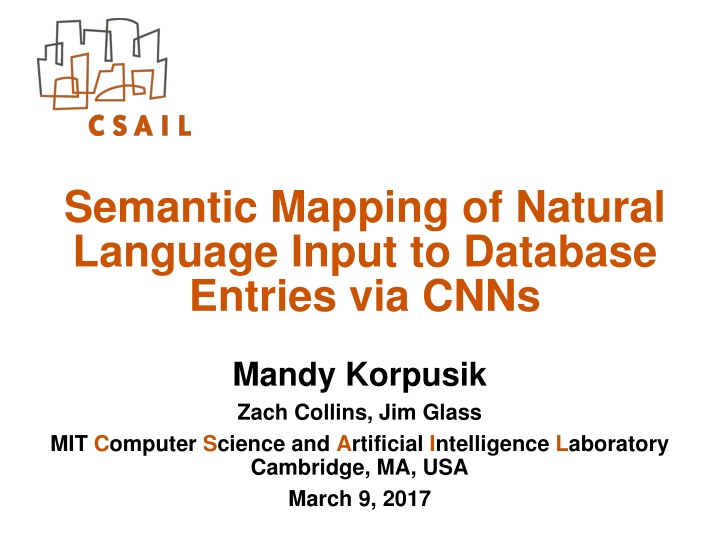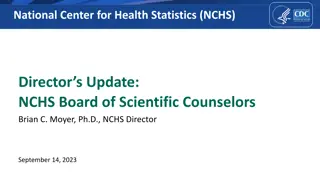
Semantic Mapping of Natural Language Input to Database Entries via CNNs
Explore how CNNs are used for semantic mapping of natural language input to database entries, as discussed by Mandy Korpusik, Zach Collins, and Jim Glass from MIT Computer Science and Artificial Intelligence Laboratory. The approach involves directly mapping input to the USDA database for accurate information retrieval. This innovative solution replaces the old approach of simple word matching, offering a more advanced and efficient method for data collection and analysis.
Uploaded on | 1 Views
Download Presentation

Please find below an Image/Link to download the presentation.
The content on the website is provided AS IS for your information and personal use only. It may not be sold, licensed, or shared on other websites without obtaining consent from the author. If you encounter any issues during the download, it is possible that the publisher has removed the file from their server.
You are allowed to download the files provided on this website for personal or commercial use, subject to the condition that they are used lawfully. All files are the property of their respective owners.
The content on the website is provided AS IS for your information and personal use only. It may not be sold, licensed, or shared on other websites without obtaining consent from the author.
E N D
Presentation Transcript
Semantic Mapping of Natural Language Input to Database Entries via CNNs Mandy Korpusik Zach Collins, Jim Glass MIT Computer Science and Artificial Intelligence Laboratory Cambridge, MA, USA March 9, 2017
Partial Solution: USDA MIT Computer Science and Artificial Intelligence Laboratory 3
Our Solution (Matt McEachern, Karan Kashyap) MIT Computer Science and Artificial Intelligence Laboratory 4
Old Approach: Simple Word Matching MIT Computer Science and Artificial Intelligence Laboratory 5
Problem MIT Computer Science and Artificial Intelligence Laboratory 6
New Approach: Direct Mapping to USDA for dinner I had a bowl of chili over rice and an apple chili with beans canned rice white short-grain cooked apples raw with skin MIT Computer Science and Artificial Intelligence Laboratory 7
Step 1: Data Collection MIT Computer Science and Artificial Intelligence Laboratory
Step 1: Data Collection Collected 31,712 meal logs on Amazon Mechanical Turk. NUMBER OF FOODS PER MEAL Fast Food 669 Fast Foods Restaurant Foods Breakfast 1167 Dairy and Egg Breakfast Cereals Baked Products Snack 1342 Sweets and Snacks Nut and Seeds Dinner 2570 Pasta 1270 Cereal Grains and Pasta Poultry Pork Beef Spices and Herbs Smoothie 384 Sandwich 375 Salad 232 Fruits and Fruit Juices Vegetables Legumes Sausages and Luncheon Meat MIT Computer Science and Artificial Intelligence Laboratory 9
Step 2: Convolutional Neural Networks (CNN) Yan Lecun et al: Very deep CNNs for text classification Yoon Kim et al: CNNs for sentence classification Sentence matching Liang Pang et al: Text matching as image recognition Baotian Hu et al: CNN architectures for matching natural language sentences Wenpeng Yin et al: ABCNN:Attention-Based CNN for Modeling Sentence Pairs MIT Computer Science and Artificial Intelligence Laboratory 10
Step 2: Convolutional Neural Networks (CNN) Matches: 1. bread, white 2. bread, wheat 3. bread, rye CNN I had a slice of toast MIT Computer Science and Artificial Intelligence Laboratory 11
Step 2: Convolutional Neural Networks (CNN) Predict: 1 (Match) or 0 (Not Match) Sigmoid Meanpool 100 Dot Products (1, 64) (100, 64) Normalize Normalize Dropout Dropout Maxpool CNN (64 filters, w=3 tokens) CNN CNN Embedding (50d) 0 0 0 for dinner i had a bowl of chili over rice and an apple Padded Input 0 0 0 chili with beans Meal Description USDA Food Match? MIT Computer Science and Artificial Intelligence Laboratory 12
Step 3: Predicting USDA Matches Predicted Matches: 1. chili with beans canned 2. rice white short grain cooked 3. apples raw with skin Meal CNN for dinner I had a bowl of chili over rice and an apple for dinner I had a bowl of chili over rice and an apple MIT Computer Science and Artificial Intelligence Laboratory 13
Step 3: Finite-State Transducer (FST) Meal FST Compose Food FST MIT Computer Science and Artificial Intelligence Laboratory 14
Step 3: Finite State Transducer (FST) FST decoder generates predicted USDA food matches. Meal: I had a bowl of cereal , one egg white , and a glass of juice . Alignment: Other Other Other Other Other ID8243 Other Other ID1124 ID1124 Other Other Other Other Other ID9233 Other USDA Items: ID8243: Cereals ready-to-eat, GENERAL MILLS, HONEY NUT CLUSTERS ID1124: Egg, white, raw, fresh ID9233: Passion-fruit juice, yellow, raw MIT Computer Science and Artificial Intelligence Laboratory 15
Re-training CNN with Augmented Data Augment data with FST-predicted aligned tokens USDA CNN Meal CNN chili with beans canned Training Sample 1 for dinner i had a bowl of chili over rice and an apple Full Meal Description USDA Food chili with beans canned chili Training Sample 2 USDA Food Aligned Tokens MIT Computer Science and Artificial Intelligence Laboratory 16
New Model Performs Better (101 Foods) Recall: % of correctly predicted USDA foods Model Recall 78.9% 89.2% 90.6% Old: CRF tagger + USDA Lookup New: CNN + FST Top-1 New: CNN + FST Top-5 MIT Computer Science and Artificial Intelligence Laboratory 17
Analysis: Spike Profile MIT Computer Science and Artificial Intelligence Laboratory 18
Analysis: Nearest Neighbors Chicken broiler or fryers breast skinless boneless meat only raw 1. Chicken broilers or fryers drumstick meat and skin cooked fried flour 2. KFC fried chicken original recipe breast meat only skin and breading removed Cookies chocolate chip refrigerated dough baked 1. Cookies brownies commercially prepared 2. Snacks granola bars soft uncoated chocolate chip MIT Computer Science and Artificial Intelligence Laboratory 19
Ongoing and Future Research Extend to full USDA database, as well as larger Minnesota database Character-based models User testing Personalized nutrition advice Follow-up questions MIT Computer Science and Artificial Intelligence Laboratory 20






